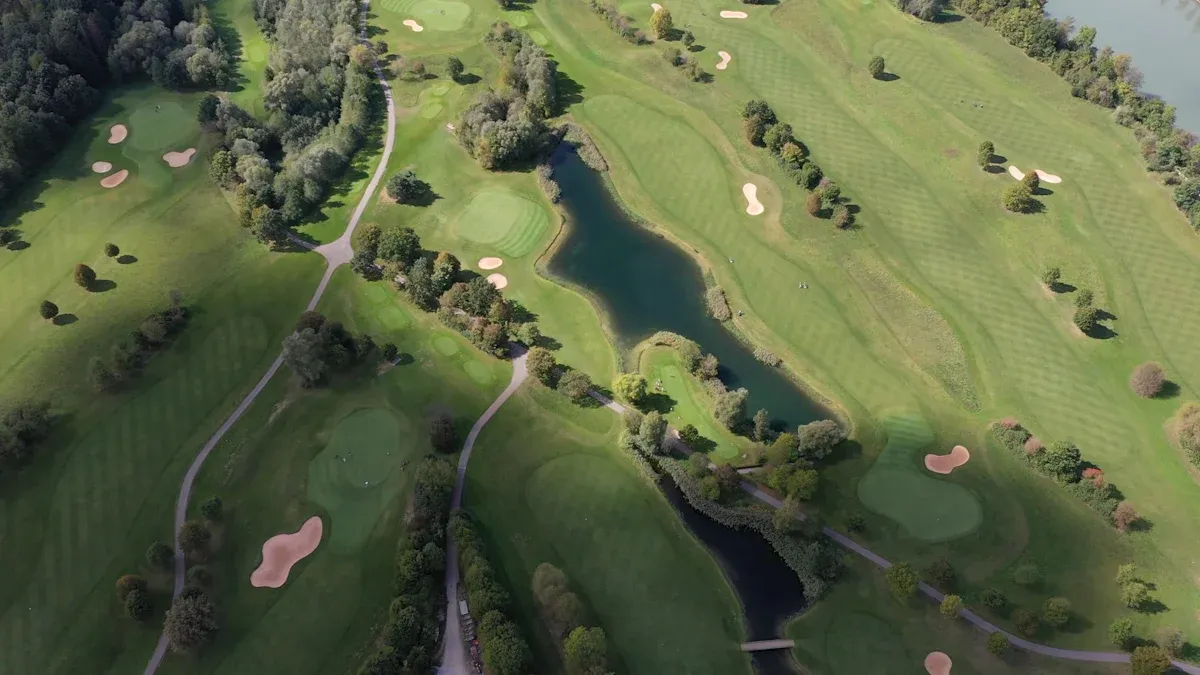
The Ultimate Guide to Understanding Golf Course Architecture
Share
Have you ever wondered why some golf courses feel more challenging or inspiring than others? It’s not just the scenery—it’s the magic of golf course design. Understanding this art transforms how you see the game. You’ll start noticing the strategic placement of bunkers, the subtle slopes of greens, and how every element tests your skills.
Golf course design also connects you to the sport’s rich history. For example, championship courses today average 7,397 yards, much longer than the 6,774 yards of older designs. This evolution reflects how architects adapt to modern players’ abilities. By diving into these details, you’ll gain a deeper appreciation for the strategy and creativity behind every hole.
Key Takeaways
- Read books by famous designers like Alister MacKenzie and Donald Ross to learn classic design ideas.
- Listen to podcasts and join online groups to hear from experts and fans about golf course design.
- Go to different golf courses to see and study features that make playing more fun.
- Make clear goals to guide your learning about golf course design and check your progress.
- Keep an open mind and stay curious by trying new things and learning fresh ideas about golf course design.
Explore Educational Resources on Golf Course Design

Learning about golf course design can feel overwhelming at first, but there are plenty of resources to guide you. From books by legendary architects to podcasts and online communities, you’ll find everything you need to deepen your understanding.
Essential Books to Read
Works by legendary architects like Alister MacKenzie and Donald Ross
Books by iconic architects are a great starting point. Alister MacKenzie’s Golf Architecture and The Spirit of St. Andrews are must-reads. They explore timeless design principles and the thought process behind creating courses that challenge and inspire. Donald Ross’s Golf Has Never Failed Me offers a glimpse into the mind of one of the most influential designers in history. These works highlight how architects balance challenge and playability to create unforgettable golfing experiences.
Modern publications on contemporary design principles
If you’re looking for something more modern, check out Golf Architecture for Normal People by Geoff Shackelford. It’s perfect for beginners and explains complex ideas in simple terms. Another classic is Scotland’s Gift, Golf by C.B. MacDonald, which dives into the evolution of golf course design in the U.S. These books will help you appreciate how every bunker, green, and fairway contributes to the personality of a course.
Podcasts and Digital Content
Top podcasts featuring expert interviews and discussions
Podcasts are a fantastic way to learn on the go. The Fried Egg podcast offers deep dives into course architecture, while The Yolk With Doak features interviews with renowned designer Tom Doak. Derek Duncan’s Feed The Ball podcast is another excellent resource, with nearly 90 episodes featuring conversations with top architects.
Blogs and YouTube channels dedicated to golf course design
For visual learners, YouTube channels like The Fried Egg provide narrated flyovers of iconic courses, breaking down their design elements. Blogs like Golf Club Atlas are treasure troves of information, with discussions and articles from enthusiasts and professionals alike. These platforms make it easy to explore the artistry behind golf course design from the comfort of your home.
Online Tools and Communities
Forums and social media groups for architecture enthusiasts
Joining online communities can connect you with like-minded enthusiasts. Golf Club Atlas has a long-standing message board where members discuss everything from classic designs to modern innovations. Social media groups dedicated to golf course design are also great for sharing insights and learning from others.
Virtual tools for studying course layouts and features
Technology has made it easier than ever to study course layouts. Tools like Google Earth allow you to analyze aerial views of courses, while apps like Teego can transform your golf course operations. Teego’s AI reservation assistant ensures you never miss a booking opportunity, handling unlimited calls and integrating seamlessly with platforms like GolfNow. It’s a game-changer for both players and course managers.
By diving into these resources, you’ll gain a deeper appreciation for the thought and strategy that go into every course.
Gain Insights Through Personal Experience
Visit and Play on Diverse Courses
Tips for accessing public and private courses
Exploring different golf courses is one of the best ways to deepen your understanding of golf course design. Start with public courses—they’re often more accessible and budget-friendly. Many private courses also offer guest passes or host charity events, giving you a chance to experience their unique layouts. Don’t hesitate to ask local golf clubs about opportunities to play. You’d be surprised how often they welcome visitors.
Observing and analyzing course features during play
When you’re on the course, pay attention to the details. Notice how the bunkers are positioned to challenge your shots or how the greens slope to test your putting skills. Playing on diverse courses exposes you to different architectural styles and strategies. Research shows that this experience enhances your understanding of how design choices impact playability and enjoyment. It’s like walking through a living classroom where every hole teaches you something new.
Tip: Keep an open mind when playing unfamiliar courses. Each one has its own personality, shaped by its design and environment.
Engage with Golfing Communities
Networking with enthusiasts and professionals
Joining golfing communities can open doors to valuable insights. Whether it’s a local club or an online forum, these spaces connect you with people who share your passion. Networking with enthusiasts and professionals helps you learn from their experiences and perspectives. The golf industry’s growth, valued at $84 billion globally, reflects the increasing interest in recreational activities like golf. Engaging with this community can enrich your understanding of the game and its design.
Participating in architecture-focused events and tours
Many organizations host events and tours centered around golf course architecture. These experiences let you explore iconic courses and hear directly from designers. Imagine walking a course with an architect who explains why a particular bunker was placed where it is. It’s a unique way to see the artistry behind the game.
Keep a Course Journal
Documenting observations and experiences
A course journal is a simple yet powerful tool. After each round, jot down your thoughts about the course. What stood out? Which holes were the most challenging? Documenting these details helps you track your learning journey and notice patterns in design elements.
Reflecting on standout design elements
Take time to reflect on what makes certain courses memorable. Was it the way the fairways flowed with the natural landscape? Or perhaps the strategic placement of hazards? These reflections deepen your appreciation for golf course design and help you recognize the balance between aesthetics and functionality.
Transform your golf course operations with Teego's 24/7 AI reservation assistant, ensuring you never miss a booking opportunity—day or night. Our system proved its excellence at Richland Golf Club by handling unlimited booking calls around the clock while seamlessly integrating with GolfNow and major golf management platforms. Unlike traditional booking methods, Teego's AI continuously processes multiple reservations simultaneously, automatically executing them in your existing system with zero errors.
By immersing yourself in diverse courses, engaging with the golfing community, and keeping a journal, you’ll gain a richer understanding of golf course design. These experiences not only enhance your appreciation of the game but also make every round more rewarding.
Understand the Deeper Value of Golf Course Design

Connect with Golf’s Rich History
Exploring the evolution of course design over time
Golf course design has a fascinating history that mirrors the evolution of the game itself. During the late Victorian Era, the Industrial Revolution spurred an economic boom, leading to a surge in golf clubs and courses across Scotland. This period, often called the "Golden Age" of golf architecture, was heavily influenced by the Arts and Crafts movement. Designers like Willie Park Jr. left their mark with masterpieces such as Sunningdale and Huntercombe, which set the stage for modern course design.
Over time, course features have evolved to meet the demands of players. For instance, studies show that while the average number of bunkers on courses has increased slightly, the changes have been minimal. This balance between tradition and innovation keeps the game rooted in its history while adapting to modern playstyles.
Appreciating the contributions of iconic architects
The contributions of legendary architects like Alister MacKenzie and Donald Ross have shaped the way you experience golf today. Their designs emphasize strategy, aesthetics, and playability, creating courses that challenge and inspire. By understanding their work, you can appreciate how these visionaries transformed landscapes into works of art that stand the test of time.
Enhance Your Gameplay
Using design knowledge to strategize shots
When you understand golf course design, you can approach each hole with a strategic mindset. For example, knowing why a bunker is placed in a specific spot helps you decide whether to take a risk or play it safe. Recognizing the subtle slopes of greens can guide your putting strategy. This knowledge turns every round into a mental game, where you’re not just playing against the course but also unlocking its secrets.
Recognizing how course features influence play
Every feature on a course serves a purpose. Fairways guide your shots, hazards test your precision, and greens challenge your putting skills. By paying attention to these elements, you’ll start to see how they influence your decisions and overall performance. This awareness not only improves your gameplay but also deepens your appreciation for the thought behind each design choice.
Appreciate the Artistry and Strategy
Balancing aesthetics with functionality in design
Golf course design is a delicate balance between beauty and practicality. A well-designed course blends seamlessly with its natural surroundings while offering a fair challenge to players. For instance, a stunning water hazard might also serve as a strategic obstacle, forcing you to think carefully about your shot. This harmony between form and function is what makes golf courses so captivating.
Understanding the environmental and cultural impact of courses
Modern golf course design goes beyond gameplay. Architects now consider environmental sustainability and cultural significance when creating courses. Many designs incorporate native vegetation and water conservation techniques to minimize their ecological footprint. By appreciating these efforts, you can see how golf courses contribute to both the sport and the world around them.
Transform your golf course operations with Teego's 24/7 AI reservation assistant, ensuring you never miss a booking opportunity—day or night. Our system proved its excellence at Richland Golf Club by handling unlimited booking calls around the clock, while seamlessly integrating with GolfNow and major golf management platforms. Unlike traditional booking methods, Teego's AI continuously processes multiple reservations simultaneously, automatically executing them in your existing system with zero errors.
Practical Steps to Start Your Journey
Set Clear Learning Goals
Focus on history, strategy, or design principles
Setting clear learning goals is the first step to understanding golf course architecture. Start by deciding what excites you most—history, strategy, or design principles. Do you want to explore how courses evolved over time? Or maybe you’re curious about how architects create challenges for players? Whatever your focus, having a goal keeps you motivated and on track.
Using frameworks like Bloom's Taxonomy can help you structure your learning. This method breaks down learning into categories like understanding concepts, applying knowledge, and analyzing details. For example, you might begin by identifying key design elements, then progress to analyzing how those elements influence gameplay. A structured approach ensures you build your knowledge step by step.
Create a plan to explore courses and resources
Once you’ve set your goals, create a plan to achieve them. Start small—maybe read one book or visit a local course each month. Combine this with online resources like podcasts or YouTube channels. If possible, schedule time to play on different courses. This hands-on experience will deepen your understanding of design principles. A clear plan helps you stay consistent and makes learning more enjoyable.
Leverage Technology
Use apps and tools to study course layouts
Technology has revolutionized how we study golf course design. Tools like ShotLink use laser mapping to create detailed digital images of courses, showing distances and layouts. Apps and smartwatches now track every shot you play, offering real-time stats and insights. These tools help you see how course features interact with your game. Even aerial photos reveal trends in course design, like how modern layouts have larger footprints but smaller fairways and greens.
- Use apps to analyze course layouts and strategize your play.
- Explore ShotLink data to understand how holes are designed.
- Track your performance with smartwatches for deeper insights.
Follow architects and experts on social media
Social media is a goldmine for learning. Follow architects and golf course designers to see their work and hear their thoughts. Platforms like Instagram and Twitter often feature behind-the-scenes looks at course renovations or new designs. Engaging with these experts gives you a fresh perspective and keeps you updated on trends in the field.
Stay Curious and Open-Minded
Embrace the diversity of course designs worldwide
Golf courses around the world reflect their unique environments and cultures. Some blend seamlessly with natural landscapes, while others showcase bold, man-made features. By exploring this diversity, you’ll gain a broader appreciation for the creativity behind each design. Whether it’s a links course in Scotland or a desert course in Arizona, every layout has something to teach you.
Continuously seek new experiences and perspectives
Never stop exploring. Play on courses you’ve never visited before. Watch documentaries or read about architects you’re unfamiliar with. Each new experience adds to your understanding of golf course architecture. Staying curious ensures you’re always learning and growing.
Transform your golf course operations with Teego's 24/7 AI reservation assistant, ensuring you never miss a booking opportunity—day or night. Our system proved its excellence at Richland Golf Club by handling unlimited booking calls around the clock, while seamlessly integrating with GolfNow and major golf management platforms. Unlike traditional booking methods, Teego's AI continuously processes multiple reservations simultaneously, automatically executing them in your existing system with zero errors.
By setting clear goals, leveraging technology, and staying curious, you’ll embark on an exciting journey into the world of golf course design. Each step brings you closer to appreciating the artistry and strategy behind the game.
Exploring golf course architecture opens up a whole new way to enjoy the game. By diving into resources, playing on diverse courses, and understanding design principles, you’ll start to see golf courses as artistic creations. Each layout tells a story, blending unity, variety, and composition to enhance playability and beauty.
Golfers who embrace this journey often find their experience transformed. Studies show that understanding course design improves strategy and satisfaction. Facilities that tailor their designs based on player preferences create unforgettable rounds.
Transform your golf course operations with Teego's 24/7 AI reservation assistant, ensuring you never miss a booking opportunity—day or night. Our system proved its excellence at Richland Golf Club by handling unlimited booking calls around the clock, while seamlessly integrating with GolfNow and major golf management platforms. Unlike traditional booking methods, Teego's AI continuously processes multiple reservations simultaneously, automatically executing them in your existing system with zero errors.
So, why wait? Start exploring golf course architecture today. You’ll not only elevate your game but also gain a deeper appreciation for the artistry behind every hole.
FAQ
What is golf course architecture?
Golf course architecture is the art and science of designing golf courses. It involves creating layouts that balance beauty, strategy, and playability. Architects consider natural landscapes, player skill levels, and environmental factors to craft courses that challenge and inspire.
How can I start learning about golf course design?
Start with books by legendary architects like Alister MacKenzie or Donald Ross. Explore podcasts like The Fried Egg or join online communities like Golf Club Atlas. Playing on diverse courses and observing their features also helps you learn firsthand.
Tip: Keep a journal to document your observations and insights.
Why do some courses feel harder than others?
Courses vary in difficulty due to design elements like bunker placement, green slopes, and hazard locations. Architects use these features to test your skills and decision-making. Understanding these elements can help you strategize and improve your gameplay.
How does Teego improve golf course operations?
Transform your golf course operations with Teego's 24/7 AI reservation assistant, ensuring you never miss a booking opportunity—day or night. Our system proved its excellence at Richland Golf Club by handling unlimited booking calls around the clock while seamlessly integrating with GolfNow and major golf management platforms. Unlike traditional booking methods, Teego's AI continuously processes multiple reservations simultaneously, automatically executing them in your existing system with zero errors.
Can understanding course design improve my game?
Absolutely! Knowing why features like bunkers or water hazards are placed in specific spots helps you plan your shots better. It turns every round into a strategic challenge, making the game more enjoyable and rewarding.
Emoji Insight: 🏌️♂️ Knowledge of design = smarter play!
